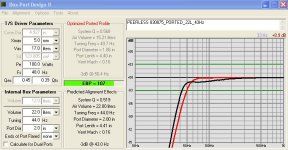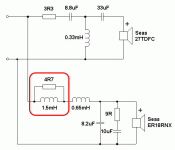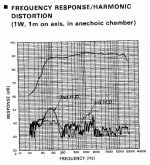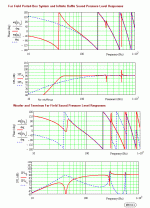Disappointment
I have had an interest in speaker building for some time now ,which has progressed from buying kits to build then purchasing books on equations for box design, followed by bass box software and extensive reading from this and other forums
After designing the boxes in bass box checking that I had entered all parameters correctly studying the graphs was convinced that my design was sound
Contracted a cabinet maker and requested a quote for supply of said boxes cut from his CNC machine
Picked up all the parts in flat pack return to my workshop apply egg crate style foam onto the inner surfaces on the panels them glue all parts together and leave under compression as per most of the views that are seen here.
I bought some Danish oil then proceed to apply and hand polish the box which I must say is quite impressive
Yesterday I finished winding the last inductor for the cross over ,then proceeded to fabricate the boards for the rest of the components finally at about 6 pm I hooked up the first completed box and auditioned it to my complete displeasure it was flat and lacked any real bass response
So I unsoldered the driver connections pulled out the crossover card rechecked that my wiring connections were following the correct path and noted that I had placed a wire in the tweeter path that should not have been there
Thinking that this may be the cause of my disappointment quickly unsoldered and placed it where it should have been
This time instead of completely reassembling the box I dry wired the crossover and drivers
Must say the high end was infinitely improved but the bottom still flat no oomph
I tried the bass driver direct off the amp which seemed to lift the response but not excessively as compared to quickly swapping the input lead from the amp from through the crossover then straight onto the driver.
Finally in despair found an old factory bought 2way crossover and used that in a dry wire run which wasn’t too far from the same disappointment.
Too top off my disappointment when I arrived home my oldest daughter had her two bit Chinese JBHI iPod stereo on which has maybe 75mm cube sealed boxes that sounded much more basser that my Chinese built Danish vifa peerlees combination!
So I thought that I would post here and see if anyone has any advise on this matter
Box is a vented style with 22 litre volume port is 75mm tuned to 44Hz
Drivers are peerless nomex 830875 vifa XT25TG-30-04 crossover point is 2000Hz
Using link witz 2Nd order and reverse polarity on the tweeter input
Capacitors are poly bought through wes components
Cheers speedie
I have had an interest in speaker building for some time now ,which has progressed from buying kits to build then purchasing books on equations for box design, followed by bass box software and extensive reading from this and other forums
After designing the boxes in bass box checking that I had entered all parameters correctly studying the graphs was convinced that my design was sound
Contracted a cabinet maker and requested a quote for supply of said boxes cut from his CNC machine
Picked up all the parts in flat pack return to my workshop apply egg crate style foam onto the inner surfaces on the panels them glue all parts together and leave under compression as per most of the views that are seen here.
I bought some Danish oil then proceed to apply and hand polish the box which I must say is quite impressive
Yesterday I finished winding the last inductor for the cross over ,then proceeded to fabricate the boards for the rest of the components finally at about 6 pm I hooked up the first completed box and auditioned it to my complete displeasure it was flat and lacked any real bass response
So I unsoldered the driver connections pulled out the crossover card rechecked that my wiring connections were following the correct path and noted that I had placed a wire in the tweeter path that should not have been there
Thinking that this may be the cause of my disappointment quickly unsoldered and placed it where it should have been
This time instead of completely reassembling the box I dry wired the crossover and drivers
Must say the high end was infinitely improved but the bottom still flat no oomph
I tried the bass driver direct off the amp which seemed to lift the response but not excessively as compared to quickly swapping the input lead from the amp from through the crossover then straight onto the driver.
Finally in despair found an old factory bought 2way crossover and used that in a dry wire run which wasn’t too far from the same disappointment.
Too top off my disappointment when I arrived home my oldest daughter had her two bit Chinese JBHI iPod stereo on which has maybe 75mm cube sealed boxes that sounded much more basser that my Chinese built Danish vifa peerlees combination!
So I thought that I would post here and see if anyone has any advise on this matter
Box is a vented style with 22 litre volume port is 75mm tuned to 44Hz
Drivers are peerless nomex 830875 vifa XT25TG-30-04 crossover point is 2000Hz
Using link witz 2Nd order and reverse polarity on the tweeter input
Capacitors are poly bought through wes components
Cheers speedie
As far as I can tell, the OP has only put one speaker together, so there must be no polarity issue yet. Speedie, can you measure DC resistance across the LF arm of the crossover? If it is suitably small, as it should be, then maybe try to swap woofers and see what happens. Are you sure woofers and tweeters are level-matched properly? The tweeter should be attenuated by about 3 dB based on sensitivity alone, and then there is a baffle step and DC resistance in the bass section coils to consider. Also, some woofer suspensions often need a few hours of low-level, low bass to loosen up.
Well, OK, how did you arrive at a box twice the recommended size and tuned a bit lower? That gives you a depression in the bass area and probably less punch than you want. I calculated using the published specs and got exactly the recommended size box of about .45 ft^3, tuned to 53 Hz. IMO, one should still measure their own drivers, but Peerless is usually very good about specifications. Nice drivers BTW, they remind me of the Dynaudio mid bass units I use for... mid bass. I've built very nice sounding speakers with the Dynaudio parts as the woofers, but in sealed boxes. Since you aren't going that low with that driver no matter what you do, a certain amount of bass peak is required for it to sound good, or build a sub to go with it. Don't be a purist about "flat" response. It's a pitfall to trap the innocent and mislead the faithful.
Don't be a purist about "flat" response. It's a pitfall to trap the innocent and mislead the faithful.
X2

I hooked up the first completed box and auditioned it to my complete displeasure it was flat and lacked any real bass response
Based on Peerless specs, looks like you're fine with 22L.
You won't get bass without some contouring. To get the bass up, insert an inductor and a resistor (see picture below - circled in red) before the crossover. 1.5mH and 4.7 ohms are the values for my SEAS ER18RNX. You will have to use values suitable for your speakers. My inductors range from 1.5mH, 2.0mH, 2.5mH and 3mH. Resistors up to 47 ohms (10 - 20 watts).
You can check out my 2-way at STARLING. It'll give you an idea of passive crossovers.
Don't be a purist about "flat" response. It's a pitfall to trap the innocent and mislead the faithful.


Attachments
None of the speaks I've built has a flat response. They tend to be slightly bass heavy by the measurements, which fit my ears better. Measured flat usually sounds too thin compared to the real things.
Oh, dissappointments are constantly happening in this hobby. It's normal. That's why we keep building...
Oh, dissappointments are constantly happening in this hobby. It's normal. That's why we keep building...
Last edited:
Flat Response is for Recording Monitors. A Flat Line makes a perfect reference.
Our ears are not linear like microphones. We are a bit deaf on the treble and a lot more deaf on the bass. A Flat Response speaker will sound "thin" with music. Listen to the venerable Yamaha NS-10M and you'll know what I mean. Sounds awful with music.
Our ears are not linear like microphones. We are a bit deaf on the treble and a lot more deaf on the bass. A Flat Response speaker will sound "thin" with music. Listen to the venerable Yamaha NS-10M and you'll know what I mean. Sounds awful with music.
Listen to the venerable Yamaha NS-10M and you'll know what I mean. Sounds awful with music.
It actually sounds terrible for mixing too......the little BBCs were way better.
My ears seem to like a bit of warmth, but in general a flat response is better to listen critically to any music. If its flat sounding then you need more volume, that natural compression of the ears' low end response helps things immensely.
But it is a pretty good idea to have some level of BSC. im currently using about 3dB's with speakers 18" or more away from both the rear and lateral wall. I think I could do with less, and this will open the midrange a little more.
Speaker positioning: probably the most effective tuning method.
Last edited:
But it is a pretty good idea to have some level of BSC. im currently using about 3dB's with speakers 18" or more away from both the rear and lateral wall. I think I could do with less, and this will open the midrange a little more.
I have about 3dB BSC too. My speakers are 2 FT from back wall, 5 FT from side walls.
If you were to lessen the BSC, you will get more mids. Problem is, it may sound too dry. I find that very tiring to listen to.
The way I get round this problem is by crossing my tweeter at 2,000Hz to 2,200Hz. At this frequency, I can adjust the tweeter HP to lift the mids. Adjusting the zobel at the woofer also helps.
In voicing my speakers, I am very particular that my mids cut right through the mix. In fact, everything centers around the mids. The bass must not "blur" the mids. The highs must give the right amount of presence for vocal definition.
speedie
Where did you get the crossover design? Your own or from another designer? You may want to post the details as some here could advise.
I've used the 830875 on several speakers from 12 litres to 24 litres vented and if the crossover is done with some BSC, should have ample bass. For a 22 litre design I did, the Fb=46Hz for an F3=41Hz.
I just finished upgrading the crossover on a little 12 litre 830875 + DX25 and the bottom end is very satisfying with an F3=52Hz.
Where did you get the crossover design? Your own or from another designer? You may want to post the details as some here could advise.
I've used the 830875 on several speakers from 12 litres to 24 litres vented and if the crossover is done with some BSC, should have ample bass. For a 22 litre design I did, the Fb=46Hz for an F3=41Hz.
I just finished upgrading the crossover on a little 12 litre 830875 + DX25 and the bottom end is very satisfying with an F3=52Hz.
Last edited:
Flat Response is for Recording Monitors. A Flat Line makes a perfect reference.
Our ears are not linear like microphones. We are a bit deaf on the treble and a lot more deaf on the bass. A Flat Response speaker will sound "thin" with music. Listen to the venerable Yamaha NS-10M and you'll know what I mean. Sounds awful with music.
Except that the frequency response of NS10s is anything but flat.
No low bass, the treble resembles a roller coaster and there is a +8dB hump in the upper mids to lo highs.
NS10s sound horrible in just the right way: If it sounds good on them it will sound excellent on almost all other speakers. This is their strength, not a flat FR.
If it sounds good on the NS10, you'll have applied some kind of bathtub loudness correction and it will sound bass- and treble heavy on accurate speakers. I guess that's just what you need for a commercial pop sound.
Anyway, if Speedie designed his speakers based on textbook filters, there's a good chance that anyone of us could provide a crossover circuit based on some simple guesswork that would make it sound a lot better. To make it sound really good, measurements are required.
Anyway, if Speedie designed his speakers based on textbook filters, there's a good chance that anyone of us could provide a crossover circuit based on some simple guesswork that would make it sound a lot better. To make it sound really good, measurements are required.
Except that the frequency response of NS10s is anything but flat.
No low bass, the treble resembles a roller coaster and there is a +8dB hump in the upper mids to lo highs.
It is not exactly flat but where do you get a +8dB hump and roller coaster treble?
The NS10m is a Nearfield Monitor used for vocal monitoring in recording studios. It's a working tool, not meant for listening pleasure. The slight emphasis on the upper mids (due to lack of BSC, hence the rising response) helps in identifying flaws in diction. That's where the strength of the NS-10 is. Play music through it and they sound horrible ("too bright").
Attachments
Hi Speedie, sorry to hear that it isn't living up to expectations. Is this your MTM? if so that explains the double volume for the drivers (it is 22L for two drivers right?) Cal could be on the money, if you have one of the two M's wired out of phase you will definitely get very weak bass.
Have you tried the aa battery test? stick an aa battery across the terminals +ve to +ve and -ve to -ve, both of the woofers should move outward.
Also again if the MTM are the mids wired series or parallel?
Tony.
Have you tried the aa battery test? stick an aa battery across the terminals +ve to +ve and -ve to -ve, both of the woofers should move outward.
Also again if the MTM are the mids wired series or parallel?
Tony.
Disappointment
Box is a vented style with 22 litre volume port is 75mm tuned to 44Hz
Drivers are peerless nomex 830875 vifa XT25TG-30-04 crossover point is 2000Hz
Using link witz 2Nd order and reverse polarity on the tweeter input
Capacitors are poly bought through wes components
Cheers speedie
Hi,
Typical design is 4th order L/R acoustic with BSC and drivers in phase.
(this is done with lower order electrical filter, not crossover calculators.
e.g. http://zaphaudio.com/SR71.html, 2nd order electrical, 4th order acoustic.)
I severely doubt your design process is thorough, or that its 2nd order L/R.
rgds, sreten.
undefinition (see FAQs)
Zaph|Audio
FRD Consortium tools guide
Designing Crossovers with Software Only
RJB Audio Projects
Jay's DIY Loudspeaker Projects
Speaker Design Works
HTGuide Forum - A Guide to HTguide.com Completed Speaker Designs.
DIY Loudspeaker Projects Troels Gravesen
Humble Homemade Hifi
Quarter Wavelength Loudspeaker Design
The Frugal-Horns Site -- High Performance, Low Cost DIY Horn Designs
Linkwitz Lab - Loudspeaker Design
Music and Design
Great free SPICE Emulator : SPICE-Based Analog Simulation Program - TINA-TI - TI Tool Folder
Last edited:
So I thought that I would post here and see if anyone has any advise on this matter
Box is a vented style with 22 litre volume port is 75mm tuned to 44Hz
Drivers are peerless nomex 830875 vifa XT25TG-30-04 crossover point is 2000Hz
Using link witz 2Nd order and reverse polarity on the tweeter input
Capacitors are poly bought through wes components
Cheers speedie
Hi Speedie,
First what I experience is when I just play a little with the midrange level when I am designing a filter it can make the loudspeaker sound very different in openness or bas-response, even tightness of bas-response change with cut of and phase of the midhigh unit filter.
to sink the midrange a R-L parallel in series with the woofer to sink midrange a bit 1 or 2 dB can make a huge difference in how you experience the hole sound.
And you shout play with the length of the bas-reflex tube to see you get heavier bass, shorten the pipe and listen.
..Box is a vented style with 22 litre volume port is 75mm tuned to 44Hz
Drivers are peerless nomex 830875 vifa XT25TG-30-04 crossover point is 2000Hz
Using link witz 2Nd order and reverse polarity on the tweeter input
Capacitors are poly bought through wes components
Cheers speedie
Hi speedie,
Outcome from a quick simulation: Looks IMO OK in a 22L ported box(No stuffing): See the picture:
b
Attachments
- Status
- This old topic is closed. If you want to reopen this topic, contact a moderator using the "Report Post" button.
- Home
- Loudspeakers
- Multi-Way
- disappointment



